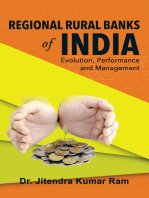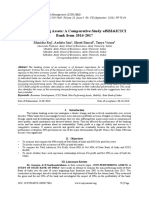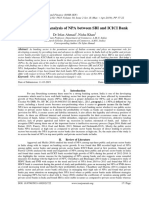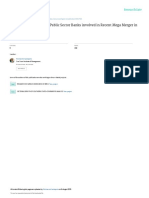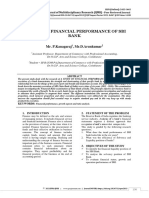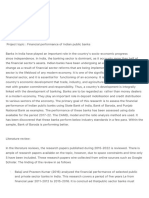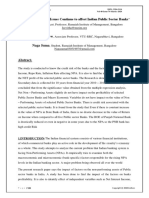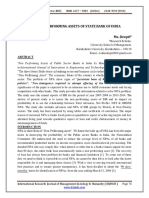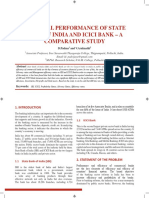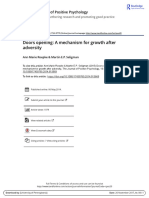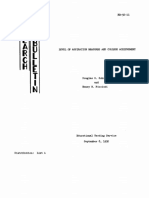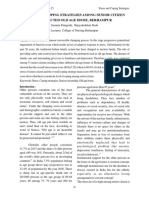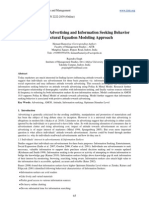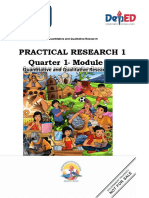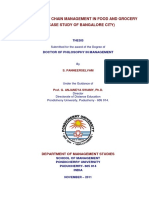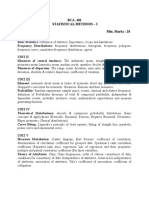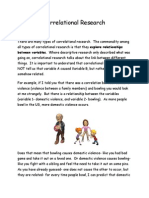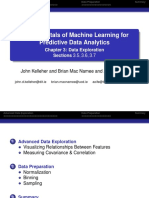Non-Performing Assets: A Comparative Study Ofsbi&Icici Bank From 2014-2017
Non-Performing Assets: A Comparative Study Ofsbi&Icici Bank From 2014-2017
Uploaded by
jassCopyright:
Available Formats
Non-Performing Assets: A Comparative Study Ofsbi&Icici Bank From 2014-2017
Non-Performing Assets: A Comparative Study Ofsbi&Icici Bank From 2014-2017
Uploaded by
jassOriginal Description:
Original Title
Copyright
Available Formats
Share this document
Did you find this document useful?
Is this content inappropriate?
Copyright:
Available Formats
Non-Performing Assets: A Comparative Study Ofsbi&Icici Bank From 2014-2017
Non-Performing Assets: A Comparative Study Ofsbi&Icici Bank From 2014-2017
Uploaded by
jassCopyright:
Available Formats
IOSR Journal of Business and Management (IOSR-JBM)
e-ISSN: 2278-487X, p-ISSN: 2319-7668. Volume 20, Issue 9. Ver. VII (September. 2018), PP 78-84
www.iosrjournals.org
Non-Performing Assets: A Comparative Study ofSBI&ICICI
Bank from 2014-2017
Manisha Raj1, Aashita Jain2, Shruti Bansal3, Tanya Verma4
1
(Associate Professor, Amity School of Economics, Amity University, India)
2
(Student, Amity School of Economics, Amity University, India)
3(Student, Amity School of Economics, Amity University, India)
4(Student, Amity School of Economics, Amity University, India)
Corresponding Author:Aashita Jain
Abstract The banking system of an economy is of foremost importance for its financial and economic
development. It forms the core of the financial sector and plays a critical role in transmitting monetary policy
impulses to the entire economic system. Hence the stability of banking sector is of paramount importance for the
development of an economy. To ensure the firmness of the banking industry, it is essential that the performance
of individual banks are checked. An important indicator today that determines the solidity of the banks are the
Non-performing Assets; but in recent times the banks have become prudent in extending advances, the reason is
increasing non-performing assets. This paper is an attempt to compare the non- performing assets of SBI and
ICICI Bank using the secondary data analysis and to comment on their individual performances too. This study
also identifies the cause of the increasing non-performing assets in the banks and a few suggestions have also
been extended.
Keywords- Economic Development, ICICI Bank, Non-Performing Assets, Stability, State Bank of India
----------------------------------------------------------------------------------------------------------------------------- ----------
Date of Submission: 23-09-2018 Date of acceptance: 08-10-2018
----------------------------------------------------------------------------------------------------------------------------- ----------
I. Introduction
The Indian banking sector has undergone a drastic change and has evolved considerably over several
decades. While banks have increasingly become more and more profitable in terms of higher revenues,
attracting foreign capital and diversifying their operations, they are also suffering from major issues such as
compromised asset quality, capital inadequacy and stressed balance sheets. This has affected the performance of
the banking sector and has raised questions about its sustainability. Today profit is a sign of vitality and success
in a competitive scenario. It ensures survival and growth and can eventually become the only parameter for
performance evaluation. NPA provisions are one of the major determinants of profit. Hence, for a bank, NPA
has become very significant.
II. Objectives
To examine and compare the NPA trends of State Bank of India and ICICI for past four years.
To list the causes of the occurrence of NPA in both the banks.
To compare the Total Advances, Net Profit, Gross NPA & Net NPA of State Bank of India and ICICI
BANK.
To check whether there exist any linear relationship between Net profit and Net NPA in case of both the
banks.
III. Literature Review
Dr. Ganesan & R.Santhanakrishnan in their research paper „NON-PERFORMING ASSETS: A
STUDY OF STATE BANK OF INDIA‟ have made an attempt to examine the non-performing assets of State
Bank of India over the past 10 years beginning from financial year 2002 to the financial year 2012.
The researchers in this paper aimed to study the sources of deployment of funds for the chosen bank. They
examined the gross and the net NPA of the bank and investigated the impact of NPA on the profitability of the
bank. They‟ve also suggested measures to improve NPA effectively in SBI.
They have made use of both primary and secondary data in this research. SBI Annual reports and
bulletins were made use of. The researchers have revealed the sources of working funds for SBI which include
deposits, borrowings, reserves and surpluses & share capital. They‟ve analysed the trends of each of the source
over the past 10 years. They have shown the net and the gross NPA tables and it has been revealed that SBI‟s
DOI: 10.9790/487X-2009077884 www.iosrjournals.org 78 | Page
Non-Performing Assets: A Comparative Study Of SBI & I Bank From 2014-2017
management of gross NPA is spectacular. The gross NPA slipped down from 9 in 2002-03 to 2.8 in 2008-09 and
according to international standards the gross NPA must not exceed 2 to 3%.
The paper‟s results and conclusion have been in favor of SBI as State Bank of India has very well
managed to keep its non- performing assets under control. This may be a result of strict watch on various
internal and external factors that could have hampered the overall growth of the bank.
Vaibhavi Shah and Sunil Sharma in their research paper titles as A COMPARATIVE STUDY OF
NPA IN ICICI BANK AND HDFC BANKhave made an attempt to study the non-performing assets of ICICI
and HDFC bank. Since, both the banks belong to the private sector of the Indian Banking industry, they aimed
at comparing the NPAs and hence the overall growth of the selected banks.
This paper aimed to know the operation of the bank in lending and credit policy and it also suggested
the steps that should be taken to reduce NPA for the banks. Next they gave the introduction of NPA and detailed
the reasons behind the rise in the NPAs.
They analyzed the gross and the net NPA of both the banks with the help of the table and respective
graphs. Comparison was based on the past 5 years from financial year 2010-11 to financial year 2014-15. Gross
NPA for ICICI Bank was impressive as it managed to maintain its NPA near to 3% according to international
standards. On the other hand, HDFC‟s performance was even better as its gross NPA values were near to 1%
and net values of NPA were all less than 1%. So, the researchers conclude the paper stating that although both
the banks are doing a great job, HDFC bank is doing exceptionally well.
D.JAYAKKODI in her research paper titled- A STUDY ON NON PERFORMING ASSETS OF
SELECT PUBLIC AND PRIVATE SECTOR BANKS IN INDIA aimed to examine and compare the Gross
NPAs and Net NPAs of select Public and Private Sector Banks. This paper consists of four Public Sector Banks-
State Bank of India, Punjab National Bank, Bank of Baroda, Bank of India and four Private Sector Banks- ICICI
Bank, HDFC Bank, AXIS Bank, and federal Bank. The study is carried out on the basis of data for the period of
5 years from 2010-11 to 2014-15. Various statistical tools namely mean, standard deviation and coefficient of
variance were used in the study.
It was realized that Public Sector Banks have higher NPA ratio as compared to Private Sector Banks over the
period of the study.
Gross and Net NPAs ratio has shown an increasing trend in selected Public Sector Banks over the period of
study.
It was observed that the Gross NPA ratio has shown a declining trend in Private Sector Banks. It was observed
that Net NPA ratio has shown an increasing trend in selected private sector banks over the period of study.
Priyanka Mohnani and Monal Deshmukh, in their paper titled as A Study of Non-Performing
Assets on Selected Public and Private Sector Banks aimed to study the trends in NPA Level and to highlight
the NPAs position of selected PSB‟s and Private Banks. They are also focused on assessing the comparative
position of NPA in selected PSBs & Private banks and to assess the variation of NPA ratio in selected PSBs &
Private banks. Selected PSBs are SBI & PNB, selected private banks are HDFC &ICICI bank. For their study,
they focused on secondary data and it has been collected using annual report of Reserve Bank of India
publication. In their study, measures of central tendency, frequency distribution, Standard Deviations,
coefficient of variation and test have been used to analyze and interpret the data. Their study focused on
examining the various aspects of NPAs in PSBs & Private banks of India (selected banks). Their study covers
the period from 2002-03 to 2011-2012. To study NPA ratio variation data over the year 2011-2012 has been
analyzed.
To be concluding, Gross NPAs ratio of PNB is less and it has been reduced over the period in
comparison to SBI. On the other side as far as Private Banks are concerned HDFC has better performance in
comparison to ICICI. So, it is very necessary for bank to keep the level of NPA as low as possible. Because
NPA is one kind of obstacle in the success of bank and affects the performance of banks negatively so, for that
the management of NPA in bank is necessary.
V.R SINGH in his paper titled A Study of Non-Performing Assets of Commercial Banks and its
Recovery in India has aimed to study the status of Non-Performing Assets of Indian Scheduled Commercial
Banks in India and their impact on the banks. He also tried to uncover the channels through which recovery of
NPA can be done. He provided the readers with some suggestions to manage NPA in near future effectively.
The data collected is mainly secondary in nature. Some of the major findings were
NPAs as a Percentage of Net Advances which was lowest 1.0 % in 2007-08 & 2008-09 and highest 5.5 %
in 2001-02. It was 2.2 % in 2013-14.
The average Percentage of Net NPAs during 2001-02 to 2013-14 was around 2.0%.
DOI: 10.9790/487X-2009077884 www.iosrjournals.org 79 | Page
Non-Performing Assets: A Comparative Study Of SBI & I Bank From 2014-2017
Ineffective recovery, willful defaults and Defective lending process are the important factors which are
responsible for the rise of NPAs in banks.
IV. Research Methodology
The present study is based on secondary data analysis. The data has been collected from various web sources
like annual reports of respective banks, information bulletins and journals.
For analyzing the data collected, correlation analysis using SPSS has been done and to compare various
parameters, charts and tables have been made use of.
Here, NPA is the independent variable and net profit is the dependent variable. So we see if due to any changes
in the net NPA, the net profits change or not, if yes, whether positively or negatively.
V. Data Analysis
In the below section, various parameters related to NPA are compared and analyzed.
Firstly, the total advances, net profits, gross NPA and net NPAs have been compared for both the banks.
YEAR TOTAL ADV. NET PROFIT GROSS NPA NET NPA
SBI ICICI SBI ICICI SBI ICICI SBI ICICI
2014 1,578,277 338,703 10,891 9,810 61,605 10,506 31,095 3,298
2015 1,692,211 387,522 13,102 11,175 56,725 15,095 27,591 6,256
2016 1,870,261 435,264 9,951 9,726 98,173 25,721 55,807 13,297
2017 1,896,887 464,232 10,484 9,801 112,343 13,297 58,277 25,451
Table-1
(Source: http://www.moneycontrol.com/financials/statebankindia/balance-sheet/SBI)
INTERPRETATION OF THE TABLE
The table is comparing Total advances with NET Profit, Gross NPA & Net NPA of SBI and ICICI
Bank. With the help of this table we can get knowledge about growing performance of both the banks. We can
see that on one side total advances given by SBI and ICICI Bank and Net Profits are increasing continuously
since 2014, which shows that banks are performing very well. But for SBI, Gross NPA & Net NPA is also
increasing such that its gross NPA in 2014 has been 61,605 and in 2017 it increased to 112,343. This shows that
SBI‟s performance is declining due to mismanagement of bank. ICICI bank shows the similar trends as its gross
and net NPAs are increasing as well since 2014.
But, if we observe carefully and compare the parameters for both the banks with each other, we see that
ICICI bank is performing much better as compared to SBI as in 2017 net NPA for SBI is 58,277 and for ICICI
bank its mere 25,451. Similarly, for Gross NPA, SBI stands at 112,343 in 2017 and at the same time, ICICI is at
13.297.
Secondly, the examination of the NPA trends for both the banks for the last 4 years has been done.
YEAR PERCENTAGE OF GROSS NPA
SBI ICICI
MARCH 2014 4.95 3.03
MARCH 2015 4.25 3.78
MARCH 2016 6.50 5.21
MARCH 2017 6.90 7.89
Table-2
DOI: 10.9790/487X-2009077884 www.iosrjournals.org 80 | Page
Non-Performing Assets: A Comparative Study Of SBI & I Bank From 2014-2017
PERCENTAGE OF GROSS NON-PERFORMING ASSET
10
ICICI
5
SBI
0
2014 2015 2016 2017
SBI ICICI
Fig-1
INTERPRETATION OF THE TABLE
The above table compares the values of gross NPA for both the banks- SBI and ICICI bank. The x-axis
show the years and on y-axis amount of gross NPA is measured. It is observed that for 3 consecutive years-
2014, 2015 and 2016, the performance of ICICI bank is showing an upwards trend as compared to that of SBI.
However, in 2017, the gross NPA value of ICICI bank shot up to 4.98 whereas SBI improved from 3.71 in 2016
to 3.81 in 2017.
YEAR PERCENTAGE OF NET NPA
SBI ICICI
MARCH 2014 2.57 0.97
MARCH 2015 2.12 1.61
MARCH 2016 3.81 2.67
MARCH 2017 3.71 4.89
Table-3
PERCENTAGE OF NET NON-PERFORMING ASSETS
4
ICICI
2
SBI
0
2014 2015 2016 2017
SBI ICICI
Fig 2
INTERPRETATION OF THE TABLE
The above table compares the values of net NPA for both the banks- SBI and ICICI bank. The x-axis
show the years and on y-axis amount of net NPA is measured. It is observed that for 3 consecutive years- 2014,
2015 and 2016, the performance of ICICI bank is showing an upwards trend as compared to that of SBI.
However, again in 2017, the net NPA value of ICICI bank increased to 7.89, SBI being on 6.90. It is also seen
DOI: 10.9790/487X-2009077884 www.iosrjournals.org 81 | Page
Non-Performing Assets: A Comparative Study Of SBI & I Bank From 2014-2017
that SBI has improved from 2016 to 2017, it has managed to reduce its non- performing assets whereas the
condition of ICICI bank has worsened.
Thirdly, we would analyze the relationship between Net profit and Net NPA in case of both the banks.
HYPOTHESIS:
H0 - There is no linear relationship between Net Profit and Net NPA; ƍ = 0
H1 - There is linear relationship between Net Profit and Net NPA; ƍ ≠ 0
(For the current study, the testing of population correlation coefficient was used to either reject or do not reject
the null hypothesis. 5 % sig level was used, i.e. α/2 = 0.25)
STATE BANK OF INDIA
YEAR NET PROFIT NET NPA
MARCH 2014 10891 31095
MARCH 2015 13102 27591
MARCH 2016 9951 55807
MARCH 2017 10484 58277
Correlation coefficient = - 0.786
Descriptive Statistics
Mean Std. Deviation N
Net 11107.0000 1384.57527 4
Profit
Net 43192.5000 16087.51129 4
NPA
Correlations
Net Profit Net NPA
Net Pearson Correlation 1 -.786
Profit
Sig. (2-tailed) .214
N 4 4
Net Pearson Correlation -.786 1
NPA
Sig. (2-tailed) .214
N 4 4
Interpretation of the value
The correlation coefficient between net profit and net NPA is -0.786 indicating the negative
relationship between the two i.e. a rise in the net NPA shall lead to a fall in the net profits. It shows there is high
negative correlation between the variables. In order to check if this result is significant, we test the hypothesis
stated above using a t-test. The test statistic is given by:
r n−2
T.S. - ∼ 𝑡n-2
1−r2
The test statistic so calculated came out to be 1.798 which lies in the acceptance region as the critical value for
the 2 tailed t- test was 4.303. Hence we do not sufficient evidence to reject the null hypothesis. Hence we say
that the correlation coefficient is not significant and there is no significant linear relationship between the net
profit and net NPA.
ICICI BANK
YEAR NET PROFIT NET NPA
MARCH 2014 9810 3298
MARCH 2015 11175 6256
MARCH 2016 9726 13297
MARCH 2017 9801 25451
Correlation coefficient = -0.39
DOI: 10.9790/487X-2009077884 www.iosrjournals.org 82 | Page
Non-Performing Assets: A Comparative Study Of SBI & I Bank From 2014-2017
Interpretation of the value
As we observe that the coefficient of correlation is equal to -0.39, it means that there is a moderate
degree of negative correlation between net profit and net NPA. The negative correlation coefficient between net
profit and net NPAs means an increase in net NPAs will decrease net profit of the bank. It is a logical
conclusion because profitability of a bank depends upon the recovery of loans and existence of bad loan will
jeopardize it. But to check if this is a significant value and that if it applies to the population as well we test the
hypothesis. The test statistic came out to be 0.598 which lies in the acceptance region as the critical value for the
t-test is 4.303. Hence, we have no evidence to reject the null hypothesis. So we can infer there is no significant
linear relationship between net profits and net NPA for ICICI bank.
Correlations
profit NPA
Net Pearson Correlation 1 -.391
Profit Sig. (2-tailed) .609
N 4 4
Net Pearson Correlation -.391 1
NPA Sig. (2-tailed) .609
N 4 4
Descriptive Statistics
Mean Std. Deviation N
Net Profit 10125.7500 700.39293 4
Net NPA 12075.5000 9854.05414 4
The insignificant correlation coefficients in case of both the banks may be due to the fact that there are
factors other than non-performing assets that impact the profitability of any bank. Some of those factors are
ROA (Return on Assets), ROE (Return on Equity), Capital Adequacy Ratio, Net interest margins etc. There
might be a case wherein the NPAs are rising but the rise in net interest margins is more as compared to the rise
in NPAs and hence the impact of net interest margins is much stronger on the net profits of the bank.
VI. Causes of NPA
One very important reason behind the rising NPA is the relaxed lending norms especially for corporate
honchos when their financial status and credit rating is not analyzed properly.
Public Sector banks provide around 80% of the credit to industries and it is this part of the credit
distribution that forms a great chunk of NPA.
Public sector lending and extending loans in agriculture sector has a substantial contribution to the rising
NPAs of the banking industry.
Inappropriate project handling, ineffective management, lack of adequate resources, day to day changing
govt. Policies produce industrial sickness. Hence, the banks finance those industries that ultimately give
them a low recovery of their loans reducing their profit and liquidity.
VII. Findings
The following findings were drawn from the above data analysis:
The total advances have shown an upwards trend for both SBI and ICICI BANK.
Net profits for SBI have been fluctuating over the years whereas in case of ICICI bank it has largely been
consistent to around 9000 crore.
In the case of % Gross NPA, performance of public sector bank- SBI is doing better as compared to private
sector bank –ICICI bank.
In case of % net NPA also, performance of SBI is observed to be improving over the years and hence
creation of less non- performing assets as compared to ICICI bank. Percentage net NPA for ICICI Bank is
observed to be continuously rising.
The coefficient of correlation for SBI was found to be -0.78 that is high negative correlation between net
profit and net NPA of the bank. This means that as NPA is increasing, the net profit will decrease.
Similarly, coefficient of correlation for ICICI bank was -0.39 that is moderate negative correlation between
net profit and net NPA.
The correlation coefficients were found to be insignificant i.e. there is no linear relationship between the net
profits and net NPA and there are other factors which impact the net profits of the bank much strongly.
VIII. Conclusion
DOI: 10.9790/487X-2009077884 www.iosrjournals.org 83 | Page
Non-Performing Assets: A Comparative Study Of SBI & I Bank From 2014-2017
The management of nonperforming assets is a daunting task for every bank in the banking industry.
The very important reason and necessity for management of NPA is due to their multi-dimensional effect on the
operations, performance and position of bank. Results of study shed light on the status of non-performing assets
of SBI and ICICI Bank.
The present study concludes that non- performing assets is a biggest challenge faced by both ICICI
bank and State Bank of India as it leads to downfall in liquidity balance of the banks and creates bad debts on
them. Profitability is being affected due to the fluctuations in NPA levels over the years. On comparing the two
banks based on the effect on its profitability, SBI has higher NPAs as compared to ICICI bank because of its
public nature. Since SBI is a public sector bank, it is more vulnerable to give up on the returns of the loans
extended to the general public. This is the reason for high NPAs in SBI. One other reason for high NPAs can be
a sharp rise in the provisioning of the bad loans. Besides rising NPA, SBI has managed to keep its profits
consistent, which depicts that the overall management of the resources of the bank is partially better. On the
other hand, the net NPAs for ICICI Bank are continuously increasing since 2014 but as compared to SBI they
are in a much better condition. The profits of ICICI bank also did not experience any sharp rise or fall. The
correlation coefficient is -0.78 which depicts high degree of negative correlation. On the other hand ICICI has a
moderate degree of correlation i.e. -0.39. But since it was found that these coefficients were insignificant, it
widens the scope for further detailed studies by identifying the impact of various other factors on profits of a
bank.
IX. Suggestions
The banker should take utmost care by ensuring that the enterprise or business for which a loan is sought is
a sound one and the borrower is capable of carrying it out successfully, he should be a person of high
integrity, credibility and good character.
The banks, instead of providing loans to small farmers, should make provisions to grant them insurance
policies for crop protection and income security.
Government should make considerate level of investment on the upliftment of the farm equipment so that
multiple farmers can make use of those facilities and there need not be any compulsion for the farmers to
take loans in order to grow their crops.
Banker should examine the balance sheet which shows the true picture of business will be revealed on
analysis of profit/loss a/c and balance sheet. While extending loans, banks should examine the purpose of
the loan. Banks must grant loan for productive purpose only.
Bibliography
[1]. Dr. D. Ganesan R.Santhanakrishnan, “Non-Performing Assets: A Study of State Bank of India” Asia Pacific Journal of Research,
Volume: I, Issue: X, October 2013.
[2]. D.Jayakoddi and Dr.P.Rengarajan, “A Study on Non- performing Assets of selected public and private sector banks in India” ,
Intercontinental Journal of Finance Research Review ISSN: 2321-0354 - Online ISSN: 2347-1654 - Print – Impact of Factor: 1.552
VOLUME 4, ISSUE 9, and September 2016.
[3]. Vaibhavi Shah and Sunil Sharma, “A Comparative Study of NPA in ICICI Bank and HDFC Bank”, Avinava national Monthly
Referred Journal of Research in Commerce and Management. Vol.5, Issue 2. Feb. 2016.
[4]. Dr. Biswanath Sukul, “Non-Performing Assets (NPAs): A Comparative Analysis of Selected Private Sector Banks”, International
Journal of Humanities and Social Science Invention ISSN (Online): 2319 – 7722, ISSN (Print): 2319 – 7714 www.ijhssi.org
||Volume 6 Issue 1||January. 2017 || PP.47-53.
IOSR Journal of Business and Management (IOSR-JBM) is UGC approved Journal with Sl.
No. 4481, Journal no. 46879.
Manisha Raj" Non-Performing Assets: A Comparative Study Of Sbi & Icici Bank From 2014-
2017” IOSR Journal of Business and Management (IOSR-JBM) 20.9 (2018): 78-84.
DOI: 10.9790/487X-2009077884 www.iosrjournals.org 84 | Page
You might also like
- Regional Rural Banks of India: Evolution, Performance and ManagementFrom EverandRegional Rural Banks of India: Evolution, Performance and ManagementNo ratings yet
- Quiz 4 - Practice PDFDocument8 pagesQuiz 4 - Practice PDFNataliAmiranashvili100% (2)
- Non-Performing Assets: A Comparative Study Ofsbi&Icici Bank From 2014-2017Document8 pagesNon-Performing Assets: A Comparative Study Ofsbi&Icici Bank From 2014-2017Shubham RautNo ratings yet
- Non-Performing Assets: A Comparative Study Ofsbi&Icici Bank From 2014-2017Document22 pagesNon-Performing Assets: A Comparative Study Ofsbi&Icici Bank From 2014-2017Alok NayakNo ratings yet
- Non-Performing Assets: A Comparative Study of SBI & ICICI Bank From (2014-2017)Document32 pagesNon-Performing Assets: A Comparative Study of SBI & ICICI Bank From (2014-2017)Alok NayakNo ratings yet
- IJCRT2302665Document7 pagesIJCRT2302665meetbhagat47No ratings yet
- NPAsDocument17 pagesNPAsanirudh sharmaNo ratings yet
- Financial Performance of Private Sector Banks With Reference To ICICI Bank and Selected Private BanksDocument21 pagesFinancial Performance of Private Sector Banks With Reference To ICICI Bank and Selected Private BanksMayank TeotiaNo ratings yet
- Ijm 11 12 179Document11 pagesIjm 11 12 179Vinayak PadaveNo ratings yet
- A Study of Financial Performance Evaluation of Banks in IndiaDocument11 pagesA Study of Financial Performance Evaluation of Banks in IndiaRaghav AryaNo ratings yet
- A Comparative Study of Financial Permormance of State Bank of India and ICICI BankDocument10 pagesA Comparative Study of Financial Permormance of State Bank of India and ICICI Bankprteek kumarNo ratings yet
- Causal Analysis of Profitability and Non-Performing Asset of Selected Indian Public and Private Sector BanksDocument7 pagesCausal Analysis of Profitability and Non-Performing Asset of Selected Indian Public and Private Sector BanksZoya AhmedNo ratings yet
- Comparative Study of Non - Performing Assets (Npas) in Selected Public Sector Banks and Private Sector Banks in IndiaDocument17 pagesComparative Study of Non - Performing Assets (Npas) in Selected Public Sector Banks and Private Sector Banks in Indiakundan nishadNo ratings yet
- A Comparative Analysis of NPA Between SBI and ICICI Bank: DR Irfan Ahmad, Nisha KhanDocument6 pagesA Comparative Analysis of NPA Between SBI and ICICI Bank: DR Irfan Ahmad, Nisha Khanharshita khadayteNo ratings yet
- 7a3a PDFDocument6 pages7a3a PDFharshita khadayteNo ratings yet
- Financial Performance of State Bank of India and Icici Bank - A Comparative StudyDocument9 pagesFinancial Performance of State Bank of India and Icici Bank - A Comparative StudyMrinali MahajanNo ratings yet
- A Study On Financial Performance of Sbi Bank: AbstractDocument7 pagesA Study On Financial Performance of Sbi Bank: AbstractMohini PashilkarNo ratings yet
- .. Current 2018 Feb BDj0Gy8teJzklCWDocument14 pages.. Current 2018 Feb BDj0Gy8teJzklCWRAHUL KUMARNo ratings yet
- A Comparative Study of Financial Performance of Canara Bank and Union Bank of India PDFDocument8 pagesA Comparative Study of Financial Performance of Canara Bank and Union Bank of India PDFPravin RnsNo ratings yet
- A Comparative Study of Financial Performance of Canara Bank and Union Bank of IndiaDocument8 pagesA Comparative Study of Financial Performance of Canara Bank and Union Bank of IndiaarcherselevatorsNo ratings yet
- A Comparative Study of Financial Performance of Canara Bank and Union Bank of India Dr. Veena K.P. Ms. Pragathi K.MDocument8 pagesA Comparative Study of Financial Performance of Canara Bank and Union Bank of India Dr. Veena K.P. Ms. Pragathi K.MMane DaralNo ratings yet
- SUSMITHADocument30 pagesSUSMITHAmithu mithuNo ratings yet
- Aeee PDFDocument21 pagesAeee PDFMane DaralNo ratings yet
- Anirudh Minor ProjectDocument21 pagesAnirudh Minor Projectanirudh sharmaNo ratings yet
- A Study On Financial Performance of State Bank of India: J.Nisha MaryDocument13 pagesA Study On Financial Performance of State Bank of India: J.Nisha Maryprteek kumarNo ratings yet
- A Study On Financial Analysis and Performance of HDFC BankDocument13 pagesA Study On Financial Analysis and Performance of HDFC BankKishan MishraNo ratings yet
- k1 PDFDocument7 pagesk1 PDFMegan WillisNo ratings yet
- Performance of Banking Through Credit Deposit Ratio in Public Sector Banks in IndiaDocument5 pagesPerformance of Banking Through Credit Deposit Ratio in Public Sector Banks in Indiaaaditya01No ratings yet
- INSPIRA JOURNAL OF COMMERCEECONOMICS COMPUTER SCIENCEJCECS Vol 05 No 04 October December 2019 Pages 18 To 20Document3 pagesINSPIRA JOURNAL OF COMMERCEECONOMICS COMPUTER SCIENCEJCECS Vol 05 No 04 October December 2019 Pages 18 To 20AshutoshNo ratings yet
- January 2015 1421559051 12Document3 pagesJanuary 2015 1421559051 12Kavishek KalindiNo ratings yet
- Performance of Selected Public Sector Banks Involved in Recent Mega Merger in IndiaDocument9 pagesPerformance of Selected Public Sector Banks Involved in Recent Mega Merger in IndiaShivanshu RajputNo ratings yet
- India Bank 2018.Document12 pagesIndia Bank 2018.Mihaela TanasievNo ratings yet
- Comparative Study On Financial Performance and Home Loan of Sbi and HDFC K. Pavithra, S. Kirubadevi & S. BrindhaDocument7 pagesComparative Study On Financial Performance and Home Loan of Sbi and HDFC K. Pavithra, S. Kirubadevi & S. BrindhaPooja MauryaNo ratings yet
- International Journal of Scientific Research and ReviewsDocument9 pagesInternational Journal of Scientific Research and ReviewsASWATHYNo ratings yet
- Sbi and BobDocument22 pagesSbi and Bobdeekshith maniNo ratings yet
- A Study On Financial Performance of Sbi BankDocument3 pagesA Study On Financial Performance of Sbi Bankjivak 21100% (1)
- Jyotirmoy 2Document14 pagesJyotirmoy 2hshahid9988No ratings yet
- An Analytical Study On NPA of Bank of Baroda: Yojna Bansal, Prof. (DR.) Harsh Purohit, Dr. Vijaya KumarDocument7 pagesAn Analytical Study On NPA of Bank of Baroda: Yojna Bansal, Prof. (DR.) Harsh Purohit, Dr. Vijaya KumarRavishankar HKNo ratings yet
- IJMSS2273Jan31 PDFDocument12 pagesIJMSS2273Jan31 PDFdsfgNo ratings yet
- 5 6303135003920304338Document5 pages5 6303135003920304338Syeda SanaiyaNo ratings yet
- BanksDocument5 pagesBankskamal54378No ratings yet
- Raki RakiDocument63 pagesRaki RakiRAJA SHEKHARNo ratings yet
- Vol 1 Issue 1 Art 1Document17 pagesVol 1 Issue 1 Art 1Sabana AsmiNo ratings yet
- 2dharmendra S Mistry - Pdfa Comparative Study of The Profitability Performance in TheDocument15 pages2dharmendra S Mistry - Pdfa Comparative Study of The Profitability Performance in ThePsubbu RajNo ratings yet
- Comparative Study of Public and Private Sector Banks in India: An Empirical AnalysisDocument7 pagesComparative Study of Public and Private Sector Banks in India: An Empirical AnalysisvarunNo ratings yet
- Financial Performance Analysis of PrivatDocument11 pagesFinancial Performance Analysis of Privatprteek kumarNo ratings yet
- Pub 32023Document8 pagesPub 32023Abhishek s PattanashettiNo ratings yet
- "Will Asset Quality Issues Continue To Affect Indian Public Sector BanksDocument14 pages"Will Asset Quality Issues Continue To Affect Indian Public Sector BanksShrutiNo ratings yet
- 1985-Article PaperDocument16 pages1985-Article Paperavikboss007No ratings yet
- Research MethodologyDocument12 pagesResearch MethodologyKuldeep KaushikNo ratings yet
- Analysis of Non-Performing Assets (Npas) Among Sbi Bank and Icici Bank For Operating 2011-2018Document17 pagesAnalysis of Non-Performing Assets (Npas) Among Sbi Bank and Icici Bank For Operating 2011-2018ASWATHYNo ratings yet
- Research MethodologyDocument12 pagesResearch MethodologySulo's SoulNo ratings yet
- Performance of Banking Sector in India - A Comparative Study of SBI, Icici & Citi BankDocument4 pagesPerformance of Banking Sector in India - A Comparative Study of SBI, Icici & Citi BankNaveen HemromNo ratings yet
- Review of LiteratureDocument24 pagesReview of LiteratureShveta VatasNo ratings yet
- A Study of Financial Performance of Public Sector Banks of IndiaDocument9 pagesA Study of Financial Performance of Public Sector Banks of IndiaHarshit KashyapNo ratings yet
- Synopsis On A Comparative Study On The BDocument6 pagesSynopsis On A Comparative Study On The Bharshal maliNo ratings yet
- IJCRT2203243Document10 pagesIJCRT2203243Tushar MusaleNo ratings yet
- A Study On Non-Performing Assets of State Bank of India Ms. DeeptiDocument6 pagesA Study On Non-Performing Assets of State Bank of India Ms. DeeptibhagyashriNo ratings yet
- A Study On Impact of Non-Performing AssetsDocument4 pagesA Study On Impact of Non-Performing AssetsInternational Journal of Innovative Science and Research TechnologyNo ratings yet
- 1532 PDFDocument9 pages1532 PDFChandrashekhar GurnuleNo ratings yet
- T R A N S F O R M A T I O N: THREE DECADES OF INDIA’S FINANCIAL AND BANKING SECTOR REFORMS (1991–2021)From EverandT R A N S F O R M A T I O N: THREE DECADES OF INDIA’S FINANCIAL AND BANKING SECTOR REFORMS (1991–2021)No ratings yet
- Unit 3 Statistical GraphicsDocument18 pagesUnit 3 Statistical GraphicsHafizAhmadNo ratings yet
- Amp 64 9 863Document10 pagesAmp 64 9 863Cristina ToaderNo ratings yet
- Quantitative Methods TBDocument441 pagesQuantitative Methods TBbh19980No ratings yet
- Assignment - MATHS IVDocument11 pagesAssignment - MATHS IVMande VictorNo ratings yet
- 10576-Article Text-41055-3-10-20191228 PDFDocument9 pages10576-Article Text-41055-3-10-20191228 PDFadssdasdsadNo ratings yet
- Groebner Business Statistics 7 Ch15Document70 pagesGroebner Business Statistics 7 Ch15Zeeshan RiazNo ratings yet
- Chapter 8 - : ForecastingDocument43 pagesChapter 8 - : ForecastingArchit SomaniNo ratings yet
- Level of AspirationDocument18 pagesLevel of AspirationschevroletNo ratings yet
- Stress and Coping Strategies Among Senior Citizen in Selected Old Age Home, BerhampurDocument5 pagesStress and Coping Strategies Among Senior Citizen in Selected Old Age Home, BerhampuramitNo ratings yet
- MATH 231-Statistics-Hira Nadeem PDFDocument3 pagesMATH 231-Statistics-Hira Nadeem PDFOsamaNo ratings yet
- Depth Conversion of Time InterpretationsDocument58 pagesDepth Conversion of Time InterpretationsAyu Indri FirdaniNo ratings yet
- 5 - Hemant Bamoriya & Dr. Rajendra Singh - Final PaperDocument10 pages5 - Hemant Bamoriya & Dr. Rajendra Singh - Final PaperiisteNo ratings yet
- Regression Modelling With Actuarial and Financial Applications - Key NotesDocument3 pagesRegression Modelling With Actuarial and Financial Applications - Key NotesMitchell NathanielNo ratings yet
- GCE Maths and Further Maths Getting Started GuideDocument22 pagesGCE Maths and Further Maths Getting Started GuidemohitNo ratings yet
- Practical Research 1 Q1 M4Document20 pagesPractical Research 1 Q1 M4dv vargasNo ratings yet
- Impact of Retail Atmospherics in Attracting Customers: A Study of Retail Outlets of LucknowDocument6 pagesImpact of Retail Atmospherics in Attracting Customers: A Study of Retail Outlets of LucknowkangkongNo ratings yet
- CH 10 TestDocument23 pagesCH 10 TestDaniel Hunks100% (1)
- Final - Thesis - Full PDFDocument324 pagesFinal - Thesis - Full PDFsukh2812No ratings yet
- BCA - 102 Statistical Methods - I Max. Marks: 85 Min. Marks: 28Document3 pagesBCA - 102 Statistical Methods - I Max. Marks: 85 Min. Marks: 28mayur gehlodNo ratings yet
- Correlational Research 2Document6 pagesCorrelational Research 2Carlo Mabini BayoNo ratings yet
- Umair Mazher ThesisDocument44 pagesUmair Mazher Thesisumair_mazherNo ratings yet
- S1 MindmapDocument1 pageS1 Mindmap'Tahir AnsariNo ratings yet
- Impact of Human Resource Development Practices On Employee Retention in Amara Raja Batteries Limited (Arbl), Tirupati: A Statistical AnalysisDocument6 pagesImpact of Human Resource Development Practices On Employee Retention in Amara Raja Batteries Limited (Arbl), Tirupati: A Statistical AnalysisRamesh RamzNo ratings yet
- The Influence of Woven Fabric Structure On The Woven Fabric StrengthDocument5 pagesThe Influence of Woven Fabric Structure On The Woven Fabric StrengthGagan Kumar JhaNo ratings yet
- Q2-The HRM-performance Relationship Revisited - Inspirational Motivation - Participative Decision Making and Happiness at Work HAWDocument17 pagesQ2-The HRM-performance Relationship Revisited - Inspirational Motivation - Participative Decision Making and Happiness at Work HAWHumberto Córdova TiconaNo ratings yet
- 04 The Fundamental Law of Active ManagementDocument7 pages04 The Fundamental Law of Active ManagementMeubel Remaja BanjarmasinNo ratings yet
- Chapter 4 Research Data PresentationDocument6 pagesChapter 4 Research Data PresentationDave Khyl100% (1)
- BookSlides 3B Data ExplorationDocument60 pagesBookSlides 3B Data ExplorationMba NaniNo ratings yet
- FERUM4.1 Users GuideDocument21 pagesFERUM4.1 Users GuideKenneth DavisNo ratings yet
